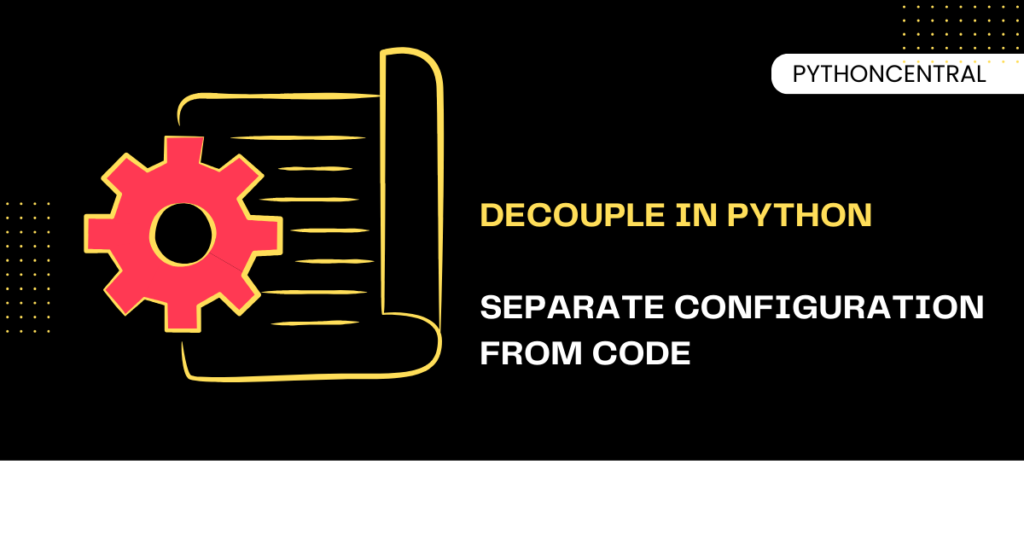 It is perfectly fine if you look at your Python applications and they look "simple". With experience and an appetite for complexity, your Python applications will continue to grow in size and dependencies. In those times, managing configuration settings directly inside your code is difficult. And as we say in PythonCentral, there is a library for that. Let us learn about the decouple library comes into the picture.
It is perfectly fine if you look at your Python applications and they look "simple". With experience and an appetite for complexity, your Python applications will continue to grow in size and dependencies. In those times, managing configuration settings directly inside your code is difficult. And as we say in PythonCentral, there is a library for that. Let us learn about the decouple library comes into the picture.
Let us learn everything there is about the decouple Python library. Use this library for cleaner, safer, and more maintainable configuration management. This article is a step-by-step guide relevant for both Python beginners and seasoned developers. Get. Set. Learn!
What is Decouple in Python
Decouple is a Python library that separates configuration parameters from source code. With this library, you can:
- Store sensitive credentials like API keys and authentication details safely
- Manage different environments (development, staging, or production)
- Avoid hardcoding settings into your Python files
In short, this is a very simple library that handles complex actions for you.
Why Should You Use Decouple
Here are a few common reasons, why you should be using the decouple library in Python in your applications:
- Keeps secrets out of version control (e.g., GitHub)
- Supports default values and type casting
- Simplifies environment-specific configurations
- Improves security and code readability
How to Install Decouple
Any guesses on which tool we will be using today to install decouple? Hint: three letters. Yes, pip it is. Let us use pip to install decouple.
pip install python-decouple
Once this command ins executed, it installs decouple library.
Instructions to Work with Decouple
Now, let us learn how to use decouple in our Python applications.
Create a .env File
Let us start by creating a .env file.
API_KEY=accesstounixmen
DEBUG=True
TIMEOUT=30
How to Load Environment Variables in Python
Next, let us load the environment variables.
from decouple import config
api_key = config('API_KEY')
debug = config('DEBUG', cast=bool)
timeout = config('TIMEOUT', cast=int)
print(api_key, debug, timeout)
Always add the .env to your .gitignore file to prevent committing secrets.
Default Values and Type Casting
We have now created a .env file and loaded the environment variables. Let us define the default values.
host = config('HOST', default='localhost')
port = config('PORT', cast=int, default=8000)
Advanced Usage
Let us explore some advanced use cases for decouple library.
Managing Different Settings Files
For bigger projects, you can have multiple .env files:
.env.development .env.production
Use the Config class manually to select the file:
from decouple import Config, RepositoryEnv
config = Config(repository=RepositoryEnv('.env.development'))
Secure Deployment
In production, set environment variables directly and Decouple will pick them up without relying on ".env" files.
Some Best Practices
As usual at PythonCentral, let us learn some best practices when you work with decouple library.
- Use type casting wherever possible ("cast=int", "cast=bool`") to avoid type errors.
- Keep different ".env" files for different environments.
- Never store your ".env" files in public repositories.
- Validate the presence of required settings at application startup.
Possible Errors You May Face
Following the instructions we provided earlier, and the best practices are enough to keep most of the errors away. Still, these are the possible mistakes a lot of us do.
- Forgetting to cast types leads to incorrect values.
- Hardcoding fallback values inside code defeats the purpose.
- Not handling missing environment variables can crash applications unexpectedly.
Applications of Decouple Library
Here are some applications where this library is used extensively:
- Web frameworks like Django and Flask heavily rely on decoupled settings.
- Serverless deployments where you manage environment settings externally.
- Dockerized applications where ".env" files are crucial for container configurations.
Wrapping Up
The decouple library is a simple yet essential tool in any serious Python project. By separating configuration from code, you create applications that are more secure, portable, and maintainable. Whether you're learning Python basics or working on a large production system, mastering decouple will dramatically improve your software development practices.
Related Articles
- 4 Benefits of Managing Configuration in Python
- Python Global Variables
- Automation Testing with Python: A Comprehensive Guide
